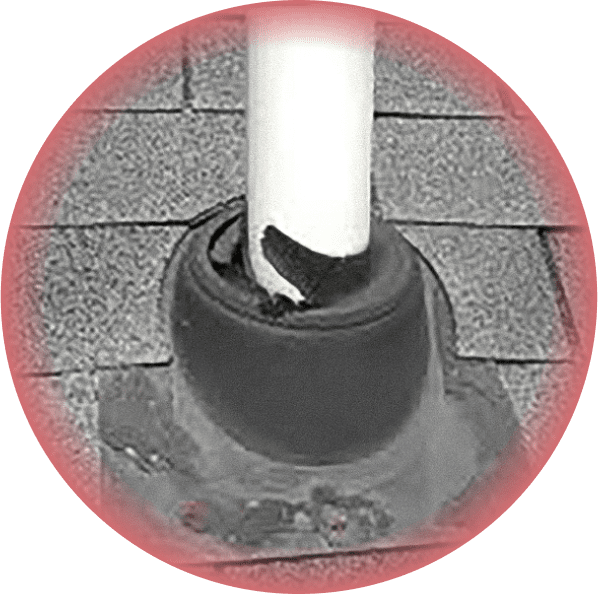
06 March 2023
What Is The Purpose Of Pipe Flashing And How Do You Properly Install It?
Pipe flashings are the number one roof leak, and that’s why they’re so important!
Pipe flashings are what the vent pipes pass through to make your roof weathertight. These pipes are necessary for your sinks, tubs, and toilets to drain. Each requires a single or shared pipe to exit the roof allowing the intake of air that enables these fixtures to drain or flush. This is the same principal as the air intake on a gas can that allows for unrestricted flow when pouring, the point is really more relevant on the older cans. Vent stacks or really intake pipes are generally made from PVC and range in size from 1 ¼” to 4”.
Pipe boot flashing, pipe collar, roof jack?
Each of these vent pipes will require a pipe flashing (also sometimes referred to as roof jacks or pipe boots) that will integrate into, or more specifically under and over your roofing material. These materials are usually shingles, tiles, slate, composition, or metal. Pipe flashings must meet or exceed many requirements that will insure a weathertight roofing system. They must also be able to properly accommodate the different angles or pitches of the roof.
Pipe Flashings must be able to withstand wind driven rain or in colder climates, snow, and icing. Another weather condition phenomenon is ice damming, this occurs when snow or ice has built up on the roof itself restricting the natural flow of the melting runoff. This can cause water to back up and pond submerging pipe flashings or any other penetrations causing roof leaks.
Overall, the harshest demand on a pipe flashing or anything else on a roof is the Sun!
The effects of the sun’s UV/ozone on any material, particularly those that are exposed on a roof, are extremely harsh and demanding. Additionally, the changing temperature throughout the many days and nights along with seasonal changes present even more demands on a pipe flashing, and that is thermal movement. The PVC vent pipe itself moves dramatically up and down in this process, expanding and contracting.
Why do pipe flashings inevitably fail?
The real problem with pipe flashings that are commercially available, they are poorly designed and made from very cheap materials. Why are they made this way? Because they’re inexpensive to buy, faster to install and a lot easier to stock, it’s that simple, and here’s why they fail.
Let’s start at the beginning, the metal or sometimes even plastic flashing plate is grossly undersized. To properly flash the roofing material the plate must reside at least three inches underneath the roof material itself. When properly installed, a quality pipe flashing will provide a weather tight seal from the elements, for decades.
Contractor Grade Pipe Flashings
Contractor Grade Pipe Flashings also incorporate a sub-par design approach that supposedly seals around the pipe. Using a very thin material (elastomer) for the seal or collar around the pipe, it’s manufactured from the least expensive resins that have the fastest process (cycle) times for only two reasons, to make the units cost cheaper and quicker to install.
The idea that this collar would snuggly compress around the pipe and form a long-term compression seal is ridiculous. Just like a rubber band when stretched, it soon relaxes and in a very short period it loses its minimal seal and fails, causing yet another leak from the pipe flashing. Also, even if the rubber seal were much thicker, just like a bungee cord, it would still relax and fail.
What else causes cheap pipe flashings to fail?
Well, there’s another design issue because the round “rubber” hole they all have which the pipe passes through becomes egg shaped when placed at pitch or at an angle. That oval only grows as it’s rotated upward to accommodate the roof’s pitch. With even a moderate pitch, it can cause the front of the rubber seal to birds’ mouth or open in the front, instant leak!
Also, one size really can’t fit all, think about it, you’re either over stretching the elastomer over the pipe that would accelerate its relaxation or tearing the hole along factory provided rib. In the case of tearing or cutting the elastomer, when closely examined, you can clearly see notches in the seal that will quickly grow and fail in very short order.
Why slow leaks from your pipe flashings are the worst type of roof leak
Slow leaks from your pipe flashings are the worst type of roof leak because they often go unnoticed. This moisture is being absorbed into the interior structure, wood sheathing, rafters, walls, and drywall and can cause rot and mold. It can also attract termites and carpenter ants, which will undoubtedly cause even more damage to your home.
If there is such a thing, the best type of roof leak is the one that is more robust and shows up on your ceiling in the form of a stain or wet spot. At least the obvious leak doesn’t generally go unnoticed causing the wood rot, mold, or decay of the building materials that the slower less obvious leaks can cause.
Why are these inferior pipe flashings even used?
It’s absolutely all about how cheap and how fast! The pitfall described in the above text can easily be prevented for two or three hundred dollars or less, about the average cost for a large home.
The answer, Lifetime Tool® Roof System Components
We developed a product called the Lifetime Tool® Ultimate Pipe Flashing®. Decades of patented roof product development and several more in the roofing industry. We went to work developing a pipe flashing that would address all the demands of a pipe laid out above.
It needed to be weathertight and last as long as any of the roofing materials. This proprietary (patented) product took all our resources, several years, and more than 25-30 prototypes to build this quality roof system component. The tooling was so complex and the experience necessary to create such a product was only possible because of years of experience in complex manufacturing.
Silicone boot
So, we started with Silicone for the boot itself. Silicone, just like sand, is made from Silica. It is “virtually unaffected by the sun’s UV or Ozone” a quote directly from Dow Corning®. Silicone is an elastomer (“rubber”) so how did the Lifetime Tool® engineers, designers and tool builders deal with the relaxation of the seal around the pipe? Two ways, the Ultimate pipe Flashing® seal is by design, always perpendicular to the pipe thus preventing the egg shaping of the flawed seal design described above. The “raft” design of the Silicone allows for more thermal movement than it will ever see and its very thick wall thickness over 3/16ths of an inch speaks to its quality.
PVC Compression Collar
We also designed a PVC compression collar that will keep the seal so tight that the entire pipe flashing has always, and we mean always, passed a laboratory test that submerges the entire pipe flashing in a test vessel with six inches of water over this same seal, for six days and six nights. This is the same way it has been displayed at hundreds of trade shows for days at a time, never once failing!
Next there’s the 24-gauge galvanized Kynar® dark bronze coated plate. It has a generous four inches of plate on its sides that gives you the proper amount of flashing under the roofing material along with its six inches on the upper plate preventing snow or pounding water from penetrating the roof system. This perimeter flashing is on average twice or more than any other manufacturer produces. Also accommodates flat to very steep 18/12” plus.
All Lifetime Tool® system components come with a weathertight warranty when properly installed for the life of the roofing material, see website for details at Lifetimetool.com. The Ultimate Pipe Flashing® is size specific to PVC, ABS and some Galv. Iron pipe, Copper and Cast Iron must use EasySleeve® or EasyFit™, see website for details.
Roger M. Cline
CEO
Lifetime Tool & Building Products LLC




